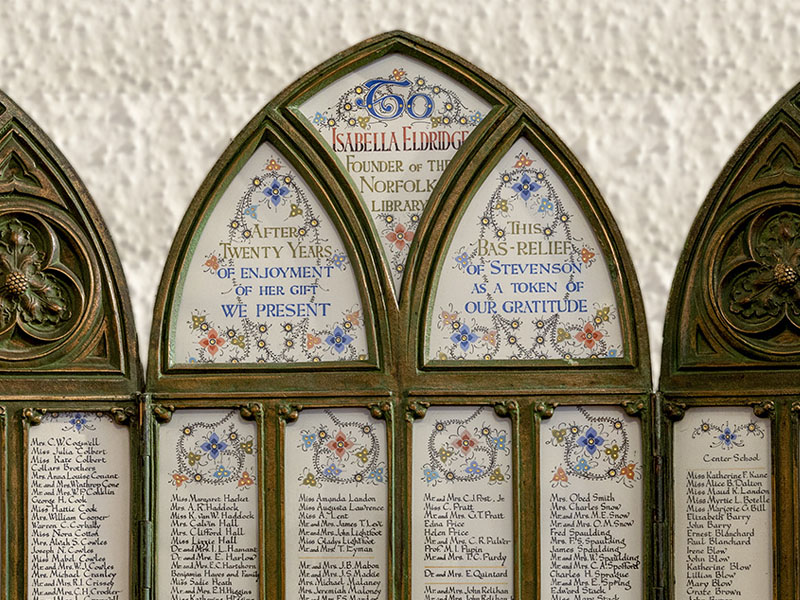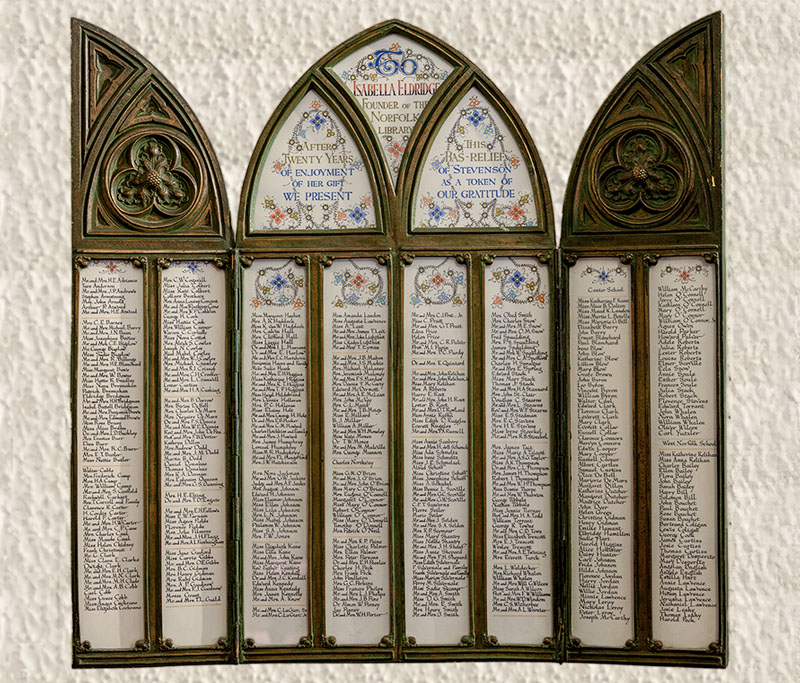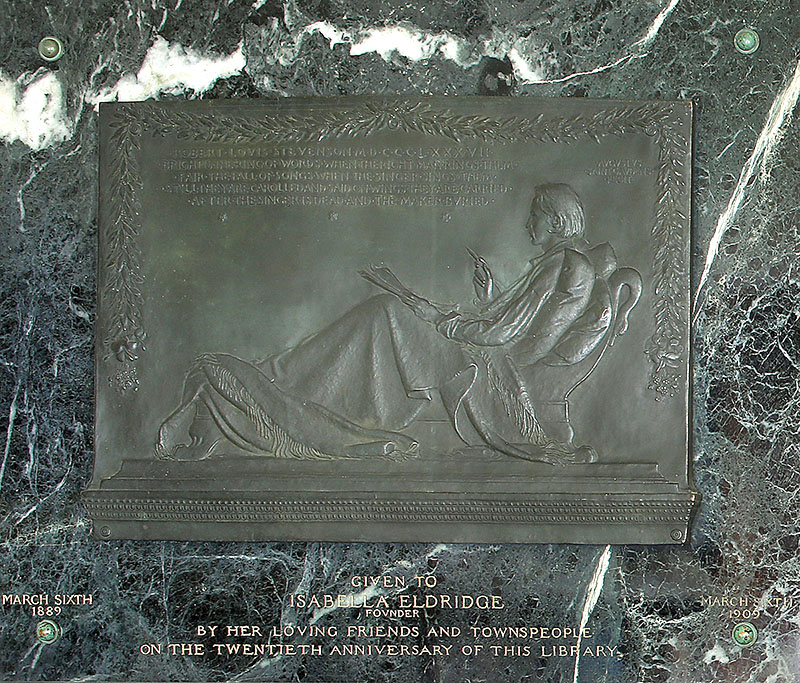
12 Aug Taylor at the Twentieth
Taylor at the Twentieth
by Ann Havemeyer
The architect Alfredo Taylor has become somewhat of a legend in Norfolk. If you are not familiar with his name, you must certainly be familiar with his work, whether dining at the Norfolk Pub in Taylor’s Royal Arcanum Building, attending services at the Catholic Church, gathering around Taylor’s War Memorial during the Memorial Day parade, walking past the handsome stone railing with artistic lamps on Maple Avenue, or climbing the granite stairs in front of the Congregational Church.
Taylor arrived in Norfolk in 1902 and within a few years had made his mark on the town, designing private residences and public buildings alike. At that time the Library was almost twenty years old, and residents were beginning to think about the upcoming anniversary and how to recognize the Library’s founder Isabella Eldridge. It was possibly Taylor who suggested the gift of a bronze bas-relief of Robert Louis Stevenson modeled by Augustus Saint-Gaudens (1848-1907), which now hangs in the Reference Room. According to the local paper, it was Taylor who designed the bronze triptych that accompanied the gift.
Robert Louis Stevenson (1850-1894) was a Scottish author, poet, and travel writer, whose literary works include such well-known titles as Treasure Island (1883), Dr. Jekyll and Mr. Hyde (1886), and A Child’s Garden of Verses (1885). Stevenson traveled to the United States in 1887 in search of a place to soothe his chronic tuberculosis. Augustus Saint-Gaudens had become an admirer of Stevenson after reading New Arabian Nights (1882), which he claimed “set me aflame as few things in literature.” When he learned that Stevenson was in this country, he arranged for an introduction through their mutual friend William H. Low.
The meeting took place in September of 1887 at the Hotel Albert in New York, where Saint-Gaudens made studies of the author on which the bas-relief would be based. During the modeling sessions, Stevenson and Saint-Gaudens became close friends and stayed in contact after Stevenson moved to the South Pacific, where the author died seven years later at the age of 44.
The bas-relief shows Stevenson reclining on a daybed, propped up with pillows and with pen and papers in hand. The inscription at the top of the original relief is a poem from Stevenson’s Underwoods (1887) dedicated to Low which reads: “Youth now flees on feathered foot/Faint and fainter sounds the flute/ … Where hath fleeting beauty led?/To the doorway of the dead/Life is over, life was gay/We have come the primrose way.”
Shortly after Stevenson died in 1894, Saint-Gaudens was asked to create a memorial to the author for St. Giles Cathedral in Edinburgh. He used a variation of the bas relief, adding a garland of laurel entwined with heather from Stevenson’s native Scotland and hibiscus native to Samoa where the author died. The Norfolk Library bas-relief is a reduced version of that memorial.
The Edinburgh reduction was cast in an edition of 10 in 1902, then in a 1908 edition of which the Library’s bas-relief is one. It is inscribed with lines of poetry from Songs of Travel and Other Verses, published in 1896, on the enduring life of words: “Bright is the ring of words when the right man rings them, Fair the fall of songs when the singer sings them, Still they are carolled and said on wings they are carried, After the singer is dead and the maker buried.”
The bas-relief is mounted on a marble plaque inscribed in gilt “Given to Isabella Eldridge, Founder, by Her Loving Friends and townspeople on the 20th Anniversary of the Library, March 6th, 1889 – March 6th, 1909.
The gift was presented with a bronze triptych described in the local paper as “exceedingly beautiful and artistic … executed by Tiffany & Co. of New York, containing the names of the donors engrossed on parchment and enclosed in a bronze frame. This frame is in the form of an old Gothic triptych, or three leaves, and is illuminated in the colors of an old missal by some of Tiffany’s most skilled artists. The inscription reads as follows: ‘To Isabella Eldridge, founder of the Norfolk Library. After twenty years enjoyment of her gift we present this bas relief of Stevenson as a token of our gratitude.’ Miss Eldridge has expressed her deep appreciation and gratitude and also her delight in its artistic excellence. The triptych was designed by the well known architect A.S.G. Taylor of Norfolk and New York.”
The list of names of those townspeople who were patrons of the Library and had contributed to the gift is extraordinary, ranging from well-known summer residents to Norfolk school children. It is surely a testament to the fact that the Library was a welcoming place to all Norfolk residents.
Among those who contributed: Dr. Edward Quintard, personal physician to Mark Twain; town doctor Irving Hamant; Isabella Beecher Hooker, women’s rights advocate and sister of Harriet Beecher Stowe; farmer Austin Wooster; Professor Michael I. Pupin, Serbian-born Pulitzer Prize winning physicist; livery man Jeremiah Maloney; Frank J. Goodnow, President of Johns Hopkins University; plumber William Thurston; James B. Mabon, President of the New York Stock Exchange; Rev. Father Keating; George W. Jenkins, President of the Remington Arms Company and his wife Helen Hartley Jenkins, benefactor of Columbia University; golf links manager Patrick Bresnahan; Frederick M. Shepard, President of the Goodyear Rubber Company; meat market merchant Dennis Halloran; salesman Olin Gibbs.
The names of eighty-four children are listed under the Center School, along with their five teachers, including Myrtie Botelle, for whom the Botelle School was later named. West Norfolk School teachers Katherine and Anna Relihan, daughters of Irish-American painter John Relihan, are listed with their students. At the top of that list are Charles, Ellen, Flora and John Bailey, children of African-American stone mason John Bailey.
In 1907, a catalog of the Library was published. Among the 74 weekly newspapers, periodicals, and monthly magazines in the Library’s reading room were English, French, German, and Italian publications. That year, to meet the demands of a growing Italian population, largely fueled by the early 20th century building boom, the Italian-American daily newspaper Il Progresso was added to the list. Librarian Philemon Johnson reported in 1909: “The paper was especially appreciated by them after the recent earthquake in Italy and for a month afterwards several extra copies were purchased and given out each day in place of one.”
Following Isabella’s death in 1919, Dr. William Henry Welch wrote: “Miss Bella desired the library to be of the greatest possible service to all … without distinction of race, creed or condition.” Taylor’s triptych would seem to verify that statement.

Bronze triptych designed by architect A.S.G. Taylor

Bronze bas-relief of Robert Louis Stevenson modeled by Augustus Saint-Gaudens




Sorry, the comment form is closed at this time.